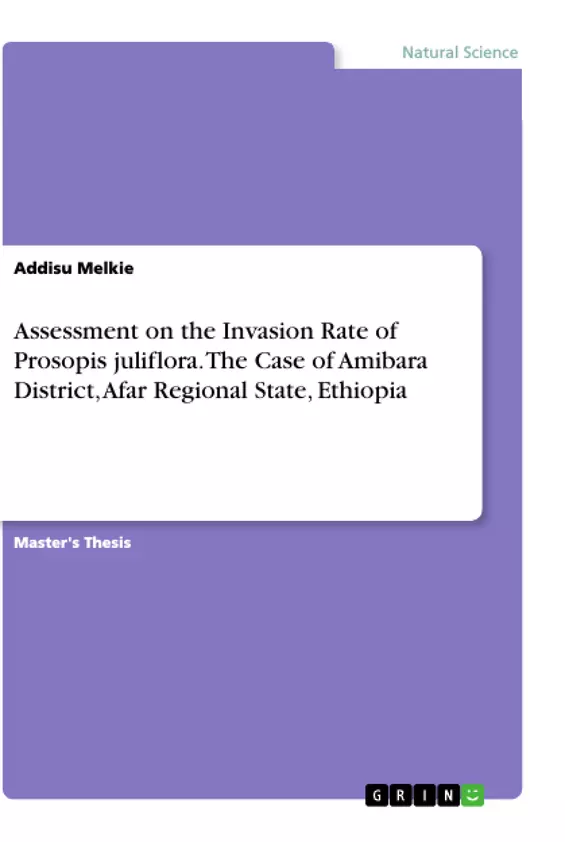P. juliflora is a powerful invader equipped with a number of special features that promote its rapid invasion of new areas. This invasive species is currently becoming a problematic weed in Ethiopia, especially in Afar Regional State. The objective of the study was to analyse the invasion rate of P. juliflora through detection LULUC using multi-temporal Landsat imagery data obtained in 1973, 1987, 1999 and 2004. A field survey was conducted to analyse impacts of invasion, to identify management techniques which reduce the invasion and re-invasion of P. juliflora and to fill the information gap that arise from the imagery analysis.
This study then reveals, over the period of 31 years, LULCC in relation to P. juliflora invasion was changed significantly. The annual invasion rate of P. juliflora during 1973-1987,1987-1999 and 1999-2004 was 5.61 km2/annum, 0.80 km2/annum and 3.95 km2/annum respectively. The average annual invasion rate was 3.45km2/annum. This study also indicated that, 121.66 km2 (23.04%), 128.56 square kilometres (24.35%),145.81 square kilometres (27.62%) and 163.064 square kilometres (30.89%) of the study area would be under P. juliflora by the year 2008, 2010, 2015 and 2020 respectively, if proper controlling measures are not taken without delay. Invasion of P. juliflora causes loss of biodiversity and ecological service, affect livelihood of the pastoralist and agro-pastoralist, crop production and human health. If properly managed it shows positive implication on the soil amelioration, micro-climate and income generation for charcoal makers. But the pastoralist and agro-pastoralist call for its eradication because under the current management system the disadvantages outweigh the advantages.
Management techniques explored was clearing and digging out of the root system below 10-30 cm from the ground, seedling uprooting with continuous follow-up during wet season, utilization of P. juliflora as a resource by making charcoal, pod collection and crushing; since livestock is the main dispersal agent of the species. To ensure the successfulness and sustainability of management techniques, commitment, participation and continuous follow up of the community and different stakeholders should be given more focus to control the invasion and re-invasion of P. juliflora.
Inhaltsverzeichnis (Table of Contents)
- Abstract
- Acknowledgement
- Acronyms
- Chapter One: Introduction
- 1.1 Background
- 1.2 Statement of the problem
- 1.3 Objective of the Study
- 1.3.1 General objective
- 1.3.2 Specific Objectives
- 1.4 Research Questions
- 1.5 Significance of the study
- 1.6 Scope of the study
- 1.7 Limitation of the study
- Chapter Two: Literature Review
- 2.1 Invasive Alien Species
- 2.2 The biology of Prosopis juliflora
- 2.3 Impacts of P. juliflora invasion
- 2.4 Management options of P. juliflora
- Chapter Three: Materials and Methods
- 3.1 Study Area
- 3.2 Materials
- 3.3 Methods
- 3.3.1 Image preprocessing
- 3.3.2 Image classification
- 3.3.3 Field data collection and analysis
- 3.3.4 Data analysis
- Chapter Four: Results and Discussion
- 4.1 Land Use/Land Cover Change Analysis
- 4.2 Impact of P. juliflora invasion
- 4.3 Management Options for P. juliflora
- Chapter Five: Conclusion and Recommendations
Zielsetzung und Themenschwerpunkte (Objectives and Key Themes)
This thesis investigates the invasion rate of Prosopis juliflora, an invasive species, in the Amibara District of Ethiopia's Afar Regional State, focusing on land use/land cover changes from 1973 to 2004. It aims to analyze the rate of invasion using multi-temporal Landsat imagery data, identify the impacts of the invasion, and explore management techniques to mitigate its spread. The study aims to fill information gaps from image analysis through field surveys.
- The invasion rate of Prosopis juliflora in Amibara District.
- The impacts of P. juliflora invasion on the environment, livelihood, and human health.
- The effectiveness of various management techniques in controlling the spread of P. juliflora.
- The role of community involvement and stakeholder collaboration in managing the invasion.
- The potential for sustainable use of P. juliflora as a resource.
Zusammenfassung der Kapitel (Chapter Summaries)
Chapter One introduces the research topic, outlining the background, problem statement, objectives, research questions, significance, scope, and limitations of the study. It highlights the increasing problem of P. juliflora invasion in Ethiopia, specifically in the Afar region, and its detrimental effects on various aspects of the ecosystem and local communities.
Chapter Two delves into the existing literature on invasive alien species, with a focus on the biology of P. juliflora, its impacts on various ecological and socioeconomic aspects, and existing management strategies. It provides a theoretical framework for understanding the invasion phenomenon and its implications.
Chapter Three describes the study area, the materials utilized for the research, and the employed methods. It details the use of Landsat imagery data, field surveys, image processing techniques, and data analysis methodologies for evaluating the rate of invasion, identifying impacts, and exploring management options.
Chapter Four presents the results of the study, encompassing land use/land cover change analysis, the identified impacts of P. juliflora invasion, and the exploration of effective management techniques. It discusses the findings in detail, drawing insights from the collected data and comparing them to existing literature.
Schlüsselwörter (Keywords)
This research focuses on the invasion of Prosopis juliflora, land use/land cover change analysis using satellite imagery and GIS, impacts of the invasion on biodiversity, livelihood, and human health, and exploration of management techniques for sustainable control. The study emphasizes the importance of community involvement and stakeholder participation for successful management strategies in the Amibara District of Ethiopia.
- Citation du texte
- Addisu Melkie (Auteur), 2009, Assessment on the Invasion Rate of Prosopis juliflora. The Case of Amibara District, Afar Regional State, Ethiopia, Munich, GRIN Verlag, https://www.grin.com/document/978793



